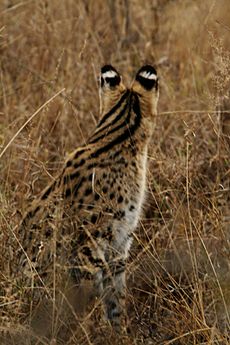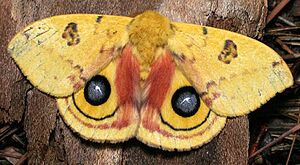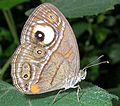Eye-spot (mimicry) facts for kids
An eye-spot (also called an ocellus) is a special mark on an animal's body that looks like an eye. You can find these eye-like patterns on many different animals, like butterflies, reptiles, cats, birds, and fish.

Eye-spots often act as a form of mimicry. This means the spot looks like the eye of a much larger or more dangerous animal. This can help protect the animal in a few ways. It might make a predator look at the eye-spot instead of a more important body part. Or, it could make the predator think the animal is unpleasant or risky to attack.
In bigger animals, eye-spots can also be used for communication with others of their own kind. They are sometimes important during courtship, which is when animals try to find a mate. The most famous example is probably the beautiful eye-spots on a peacock's tail feathers.
How Eye-Spots Protect Animals
There is strong proof that eye-spots on butterflies help them stay safe from predators. Some eye-spots are used for a startle display. This means they suddenly flash the eye-spots to distract, surprise, or scare away an animal trying to eat them. This can also make the predator attack the eye-spot instead of a vital part of the butterfly's body.
Eye-spots on butterflies can also help them recognize other butterflies of the same type. They might also play a role in sexual selection, which is how animals choose their mates. This is similar to how eye-spots are used by larger animals.
Images for kids
-
The larva (caterpillar) of an Elephant hawk moth showing its eye-spots when it feels threatened.
-
Automimicry: The gray hairstreak butterfly has a false head at its rear end to trick predators.
-
A Sand lizard with rows of eye-spots along its body.
-
A Northern pygmy owl with eye-spots on the back of its head.
-
The Foureye butterflyfish has false eyes near its tail and a mask over its real eye to hide it.
See also
 In Spanish: Ocelo (mimetismo) para niños
In Spanish: Ocelo (mimetismo) para niños










